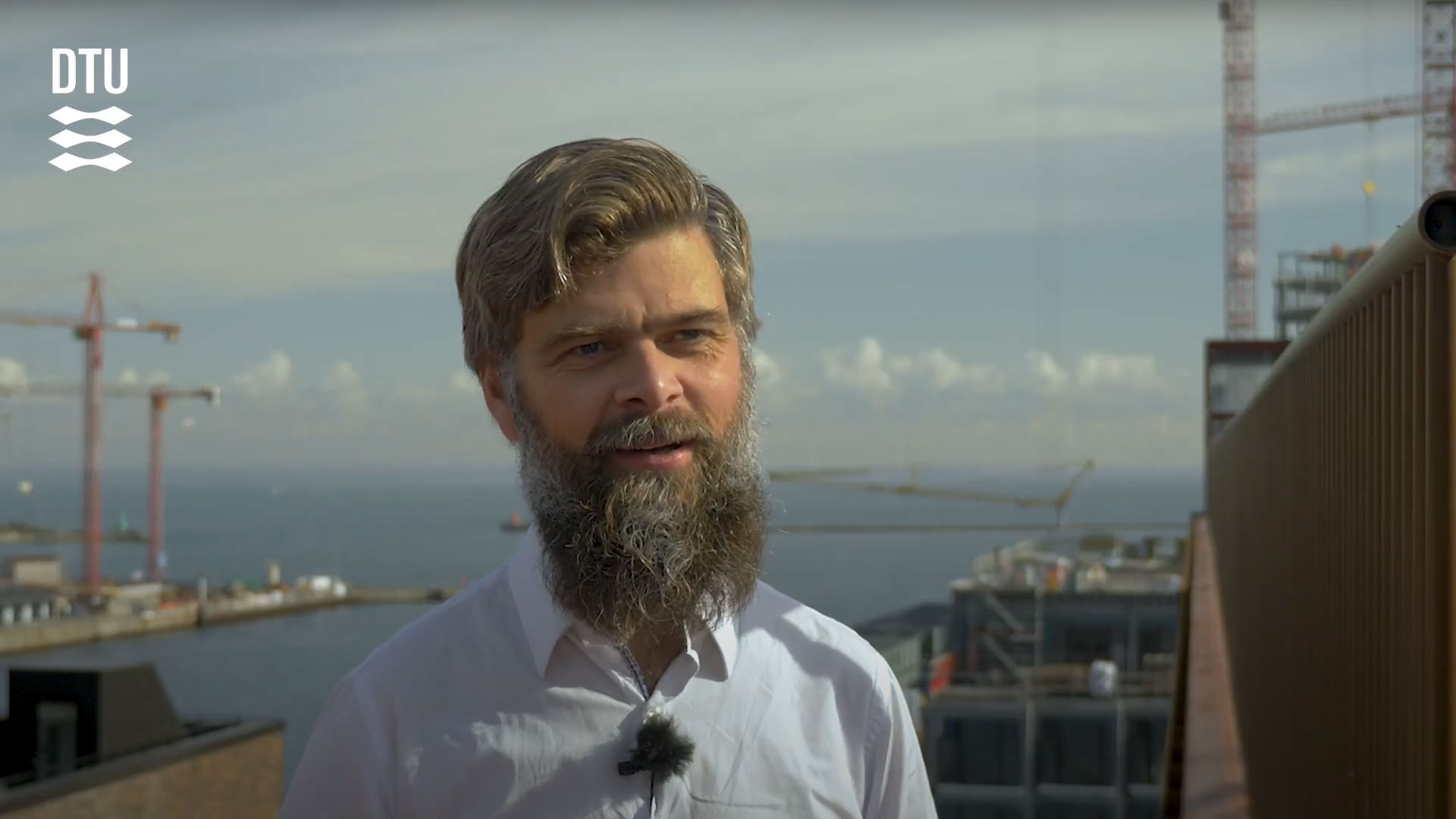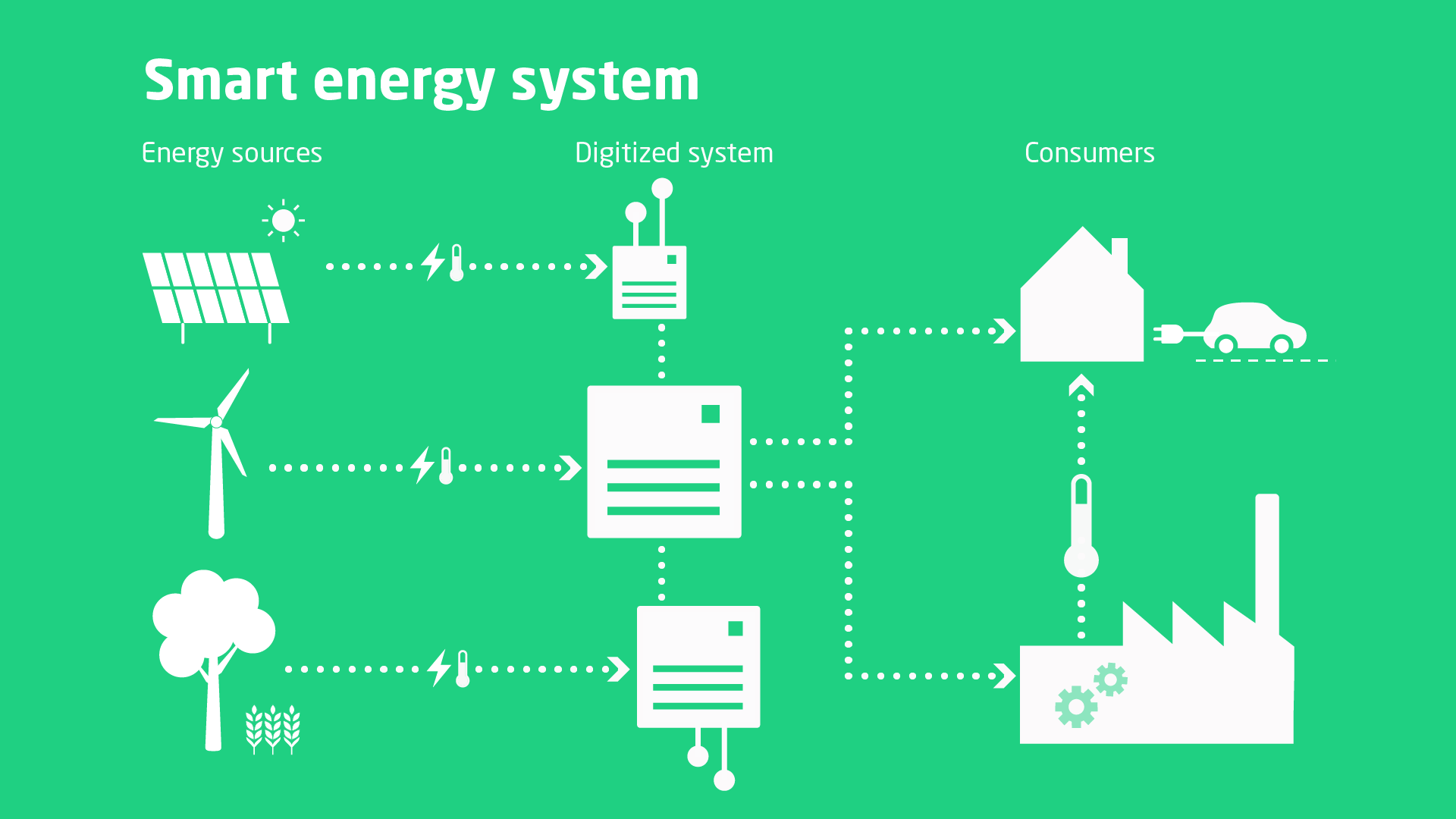What is a smart energy system?
A smart, joined-up energy system integrates all our different energy solutions. This means that the electricity, district heating and gas systems do not function as insulated silos, but are tightly interconnected. This type of energy system also includes energy that until now has been wasted. For example, this could be surplus heat from processes in companies of from fridges in supermarkets, which can be converted and used to heat buildings. Or treated waste and wastewater that can be used for energy. In a smart, interconnected energy system, these solutions are linked up so they work as part of a whole rather than separately and side by side.

A stable energy supply
Solar and wind power play an increasingly large role our energy supply and help us move towards climate neutrality.
But we also need energy when the sun isn’t shining and the wind isn’t blowing. An integrated energy system can contribute to this, so that there is a balance between production and consumption of energy. In this way, the different forms of energy can complement each other and contribute to the energy supply becoming stable.
Smart energy
At the same time, we must use energy wisely. First and foremost, this means increased digitalization.
We need a system to help us direct the energy where and when it is needed. When hundreds of thousands of green electricity, gas and heat-producing energy sources and consumers are connected in a common energy system, well-defined and standardized interfaces between the different parts of the system will be needed.
All units must ‘speak the same language’ and use the same definitions and coding in order to exchange data and perform tasks such as moving energy from one system to another.
A smart energy system also involves staggering the energy consumption, so that the supply networks are not overloaded at the times of the day when everyone needs the energy. This is typically in the morning when we all need hot water for showers, and when we come home from work and start cooking, washing clothes, watching television, etc.
With intelligent control we can ensure, for example, that electric cars are charged during periods where there is sufficient capacity in the electricity grid. And that the electric cars can supply electricity back to the grid if there is an acute shortage of electricity.
In the same way, the interaction between buildings and the heating system can be exploited more effectively. Danish buildings can easily be kept warm enough even though the heating is disconnected for a couple of hours in the morning on the coldest days, and only reconnected once there is again sufficient capacity in the climate-friendly heating systems.

Finally, in a smart energy system, the digitalization of the energy grid makes it possible for us as private consumers to live in a more climate-friendly way. We can produce, buy, sell and store energy either ourselves or together with our neighbours. For example, we can invest in solar cells, heat pumps or energy storage and ensure that they are utilized optimally.
Read more about how we can quickly achieve climate benefits with a smart energy system. Jacob Østergaard: We’re overlooking the low-hanging fruit in the green transition.
Why are smart, interconnected energy systems necessary?
Smart energy systems are essential to the development of sustainable energy systems, so that the world can achieve its goals of reducing greenhouse gas emissions and protecting the climate.
We can reduce our carbon emissions by developing new solutions such as Power-to-X and carbon capture.
But we can also limit our emissions of greenhouse gases by starting to integrate our existing energy solutions and using digitalization to create smart solutions. At bottom, it’s about thinking in terms of smart solutions and taking advantage of the opportunities we have.
A few examples: Using forecast models based on local weather forecasts, it is possible to ensure that the heat in buildings is automatically turned up and down depending on temperatures and wind conditions.
Or one can connect a large battery to a giant heat pump and coordinate their control from a holistic perspective, as has been done in the Nordhavn district in Copenhagen. The heat pump can run constantly for many hours in a row and store hot water in large containers.
To ensure balance in the energy system, the battery can be switched on and off when the heat pump does not respond quickly enough. For example, this can be done to level out the so-called boiling point in electricity consumption, when we all make dinner at the same time, or to mitigate the load on the electricity grid if many electric cars are being charged at the same time.
In future, it will also be important to think about the smart development of new technologies so that they can be included and connected with our current energy system. This is particularly important when it comes to the future power-to-X plants, which will produce a lot of excess heat when they convert electricity to other fuels. This surplus heat should of course be utilized in a smart energy system.
What role does power-to-X technology play in a smart, interconnected energy system?
Power-to-X technology is needed in an energy system based on fossil-free energy sources.
Power-to-X converts the power from renewable energy sources such as wind and solar power into, for example, hydrogen, which can either be used directly or used to produce other fuels. We need this for those areas of society that need more than electricity to function, such as heavy transport by ships and planes. In addition, some industrial production takes place at such high temperatures that it needs other forms of energy than electricity.
It is therefore essential to utilize and integrate power-to-X technologies as part of the smart and linked-up energy system. We have good conditions for doing this in Denmark. We have a well-developed district heating sector that can use the surplus heat from the power-to-X plants. We have access to sustainable carbon from biomass, which combined with hydrogen from power-to-X can be used to produce green e-biofuels such as methane, methanol or ammonia, for example for aircraft and large cargo ships.
Research into smart, interconnected energy systems
We have extensive knowledge of the individual parts of the smart, interconnected energy systems. But we lack a digital ‘control system’ that can enable the smart energy system to operate and ensure that the energy supply is both flexible and stable.
When many green electricity, gas and heat-producing energy sources and consumers are connected in a common energy system, well-defined and standardized interfaces between the different parts of the system will be needed. All units must ‘speak the same language’ and use the same definitions and coding in order to exchange data and perform tasks—such as moving energy from one system to another.
The individual components that are part of smart energy systems are developed to operate in a single isolated system, for example the electricity grid. When the components are put together across sectors, a much greater complexity arises. We need to know more about this process. And as more and more components and subsystems become connected, their operation must be optimized and automated via artificial intelligence, which is another important research area in the field of energy.
Another significant aspect of smart energy systems is their interaction with the users. Therefore, it is at least as important to research how the technique works in interplay with the people who will use it. The various combinations of solutions and technologies must be tested under realistic conditions, not just in the laboratory. This requires new approaches to research and collaboration between people across disciplines, such as engineers, economists, sociologists, architects, etc.
Rread more about local support in Marie Münster: Power-to-X: Smart collaboration across sectors and local public support can make us world leaders.
How advanced is Denmark when it comes to smart, interconnected energy systems?
In Denmark, we’ve already come a long way in terms of including green energy sources in our energy supply. In addition, we are a world leader in digitalization.
But there is still a long way to go before we can call our energy system smart and interconnected.
In part, we lack a platform or a digital management system that makes it possible to control and coordinate the many units and ensure the flexibility and stability of the system. This must first be developed and established to allow the systems to ‘talk to each other’ and exchange the necessary data. Legislation and rules also come into play here, as there are currently restrictions on how, for example, the utility companies’ data on production and consumption can be made available in a smart, linked-up energy system.
Our various energy systems, such as electricity, gas and heat, are not yet sufficiently integrated with each other. There are initiatives around the country to start this development, but it is still in the early stages and requires new initiatives and efforts to be fully developed.
A third significant challenge is that the population must also agree with the changes in the energy system. For example, not everyone is keen to have new solar cells, wind turbines, or electricity poles in their local area. Therefore, it is crucial to involve the population when finding locations for new energy sources designed to ensure green energy and the opportunity to build power-to-X plants.
What are the perspectives of smart, interconnected energy systems?
Smart energy systems are essential to the development of sustainable energy systems that can help the world achieve its goals of reducing greenhouse gas emissions and protecting the climate.
When we base our energy supply on fossil-free sources in the future, we can make the best possible use of renewable energy with smart, interconnected energy systems. Energy production from sources such as wind and solar power depends entirely on wind and weather. To secure energy at the times when the sun is not shining or the wind is not blowing, we need to create balance in the energy system. We can do this with a smart energy system.
We can also limit our emissions of greenhouse gases by starting to integrate our existing energy solutions and using digitalization to create smart solutions. At bottom, it’s about thinking in terms of smart solutions and taking advantage of the opportunities we have.
We have the opportunity to use Denmark’s prominent position in green energy technology to develop smart energy solutions. The rest of the world will need the same expertise to make the future energy supply sustainable and make it possible to connect different energy sources and consumers.
Read more in ‘Smart energy systems are the way forward: DTU sector development report (in danish).